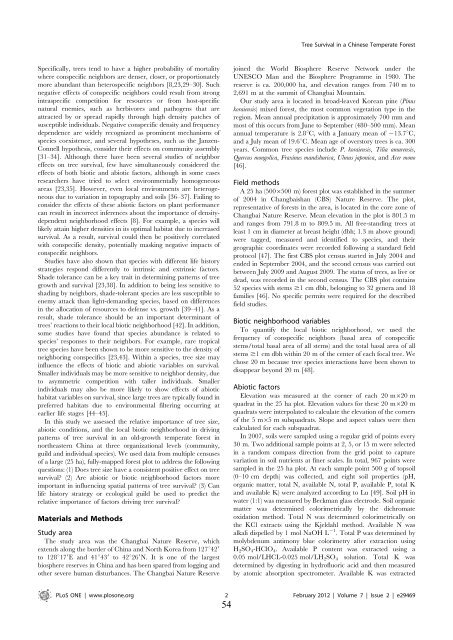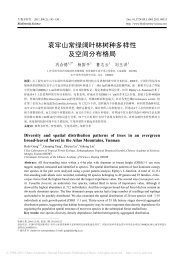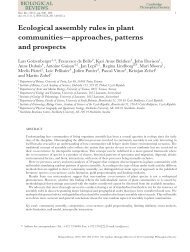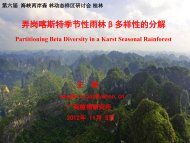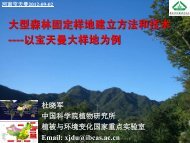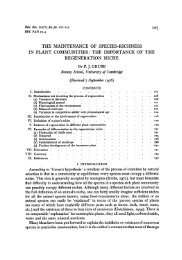Contents - ä¸å½æ£®æçç©å¤æ ·æ§çæµç½ç»
Contents - ä¸å½æ£®æçç©å¤æ ·æ§çæµç½ç»
Contents - ä¸å½æ£®æçç©å¤æ ·æ§çæµç½ç»
- No tags were found...
Create successful ePaper yourself
Turn your PDF publications into a flip-book with our unique Google optimized e-Paper software.
Tree Survival in a Chinese Temperate ForestSpecifically, trees tend to have a higher probability of mortalitywhere conspecific neighbors are denser, closer, or proportionatelymore abundant than heterospecific neighbors [8,23,29–30]. Suchnegative effects of conspecific neighbors could result from strongintraspecific competition for resources or from host-specificnatural enemies, such as herbivores and pathogens that areattracted by or spread rapidly through high density patches ofsusceptible individuals. Negative conspecific density and frequencydependence are widely recognized as prominent mechanisms ofspecies coexistence, and several hypotheses, such as the Janzen-Connell hypothesis, consider their effects on community assembly[31–34]. Although there have been several studies of neighboreffects on tree survival, few have simultaneously considered theeffects of both biotic and abiotic factors, although in some casesresearchers have tried to select environmentally homogeneousareas [23,35]. However, even local environments are heterogeneousdue to variation in topography and soils [36–37]. Failing toconsider the effects of these abiotic factors on plant performancecan result in incorrect inferences about the importance of densitydependentneighborhood effects [8]. For example, a species willlikely attain higher densities in its optimal habitat due to increasedsurvival. As a result, survival could then be positively correlatedwith conspecific density, potentially masking negative impacts ofconspecific neighbors.Studies have also shown that species with different life historystrategies respond differently to intrinsic and extrinsic factors.Shade tolerance can be a key trait in determining patterns of treegrowth and survival [23,38]. In addition to being less sensitive toshading by neighbors, shade-tolerant species are less susceptible toenemy attack than light-demanding species, based on differencesin the allocation of resources to defense vs. growth [39–41]. As aresult, shade tolerance should be an important determinant oftrees’ reactions to their local biotic neighborhood [42]. In addition,some studies have found that species abundance is related tospecies’ responses to their neighbors. For example, rare tropicaltree species have been shown to be more sensitive to the density ofneighboring conspecifics [23,43]. Within a species, tree size mayinfluence the effects of biotic and abiotic variables on survival.Smaller individuals may be more sensitive to neighbor density, dueto asymmetric competition with taller individuals. Smallerindividuals may also be more likely to show effects of abiotichabitat variables on survival, since large trees are typically found inpreferred habitats due to environmental filtering occurring atearlier life stages [44–45].In this study we assessed the relative importance of tree size,abiotic conditions, and the local biotic neighborhood in drivingpatterns of tree survival in an old-growth temperate forest innortheastern China at three organizational levels (community,guild and individual species). We used data from multiple censusesof a large (25 ha), fully-mapped forest plot to address the followingquestions: (1) Does tree size have a consistent positive effect on treesurvival? (2) Are abiotic or biotic neighborhood factors moreimportant in influencing spatial patterns of tree survival? (3) Canlife history strategy or ecological guild be used to predict therelative importance of factors driving tree survival?Materials and MethodsStudy areaThe study area was the Changbai Nature Reserve, whichextends along the border of China and North Korea from 127u429to 128u179E and 41u439 to 42u269N. It is one of the largestbiosphere reserves in China and has been spared from logging andother severe human disturbances. The Changbai Nature Reservejoined the World Biosphere Reserve Network under theUNESCO Man and the Biosphere Programme in 1980. Thereserve is ca. 200,000 ha, and elevation ranges from 740 m to2,691 m at the summit of Changbai Mountain.Our study area is located in broad-leaved Korean pine (Pinuskoraiensis) mixed forest, the most common vegetation type in theregion. Mean annual precipitation is approximately 700 mm andmost of this occurs from June to September (480–500 mm). Meanannual temperature is 2.8uC, with a January mean of 213.7uC,and a July mean of 19.6uC. Mean age of overstory trees is ca. 300years. Common tree species include P. koraiensis, Tilia amurensis,Quercus mongolica, Fraxinus mandshurica, Ulmus japonica, and Acer mono[46].Field methodsA 25 ha (5006500 m) forest plot was established in the summerof 2004 in Changbaishan (CBS) Nature Reserve. The plot,representative of forests in the area, is located in the core zone ofChangbai Nature Reserve. Mean elevation in the plot is 801.5 mand ranges from 791.8 m to 809.5 m. All free-standing trees atleast 1 cm in diameter at breast height (dbh; 1.3 m above ground)were tagged, measured and identified to species, and theirgeographic coordinates were recorded following a standard fieldprotocol [47]. The first CBS plot census started in July 2004 andended in September 2004, and the second census was carried outbetween July 2009 and August 2009. The status of trees, as live ordead, was recorded in the second census. The CBS plot contains52 species with stems $1 cm dbh, belonging to 32 genera and 18families [46]. No specific permits were required for the describedfield studies.Biotic neighborhood variablesTo quantify the local biotic neighborhood, we used thefrequency of conspecific neighbors (basal area of conspecificstems/total basal area of all stems) and the total basal area of allstems $1 cm dbh within 20 m of the center of each focal tree. Wechose 20 m because tree species interactions have been shown todisappear beyond 20 m [48].Abiotic factorsElevation was measured at the corner of each 20 m620 mquadrat in the 25 ha plot. Elevation values for these 20 m620 mquadrats were interpolated to calculate the elevation of the cornersof the 5 m65 m subquadrats. Slope and aspect values were thencalculated for each subquadrat.In 2007, soils were sampled using a regular grid of points every30 m. Two additional sample points at 2, 5, or 15 m were selectedin a random compass direction from the grid point to capturevariation in soil nutrients at finer scales. In total, 967 points weresampled in the 25 ha plot. At each sample point 500 g of topsoil(0–10 cm depth) was collected, and eight soil properties (pH,organic matter, total N, available N, total P, available P, total Kand available K) were analyzed according to Lu [49]. Soil pH inwater (1:1) was measured by Beckman glass electrode. Soil organicmatter was determined colorimetrically by the dichromateoxidation method. Total N was determined colorimetrically onthe KCl extracts using the Kjeldahl method. Available N wasalkali dispelled by 1 mol NaOH L 21 . Total P was determined bymolybdenum antimony blue colorimetry after extraction usingH 2 SO 4 -HClO 4 . Available P content was extracted using a0.05 mol/LHCL-0.025 mol/LH 2 SO 4 solution. Total K wasdetermined by digesting in hydrofluoric acid and then measuredby atomic absorption spectrometer. Available K was extractedPLoS ONE | www.plosone.org 2 February 2012 | Volume 7 | Issue 2 | e2946954


